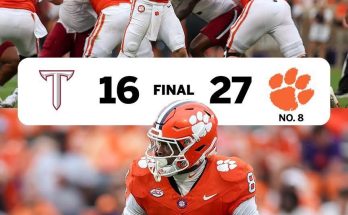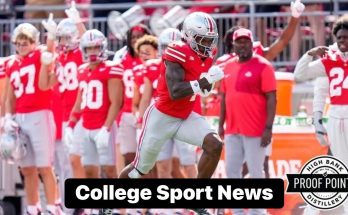In a move celebrated by fans and analysts alike, former Texas A&M football standout and the first freshman to win the Heisman Trophy, Johnny Manziel has accepted a newly created position within the Texas A&M University football program. Manziel, widely regarded as one of the greatest quarterbacks in the Aggies’ storied history, is making his official return to the program in a role that blends mentorship, player development, alumni engagement, and brand promotion. His return is not only symbolic but potentially transformative for a program that has long sought to recapture the spark and national relevance it enjoyed during Manziel’s unforgettable run in 2012 and 2013.
Manziel’s name still rings out across college football circles, not merely because of the remarkable achievements he amassed on the field, but also due to the captivating personality and style that made him a cultural icon. When Manziel became the first freshman in NCAA history to win the Heisman Trophy in 2012, he wasn’t just putting up jaw-dropping stats; he was redefining how the quarterback position could be played. Elusive, confident, and electric, Manziel turned Texas A&M into must-watch television nearly overnight, and he carried the program into the SEC era with immediate impact.
Now, more than a decade later, the university has decided to bring back one of its most beloved figures in a new capacity—one that acknowledges not only his football brilliance but also his journey off the field. After a tumultuous NFL career and very public struggles with mental health and personal decisions, Manziel has found a more centered version of himself. Texas A&M is betting that the lessons he’s learned, both positive and difficult, can be of tremendous value to its current and future players. The new position, though not a coaching role in the traditional sense, places Manziel at the heart of the program’s cultural and emotional center.
Sources within the university say that Manziel will be involved in multiple aspects of team operations. He will attend practices, be a regular presence at games, assist in quarterback training during informal sessions, and serve as a speaker at team meetings and alumni functions. The role is part ambassador, part mentor, and part cultural leader. University officials have said the position was designed with Manziel in mind—a reflection of just how impactful his presence continues to be within the Aggies’ football community.
The reaction among current players has been overwhelmingly positive. Many of them grew up watching Manziel highlights on YouTube, mimicking his spins, jukes, and daring escapes from collapsing pockets in backyard football games. For them, he’s not just a former player—he’s a legend, someone who redefined what it meant to wear the maroon and white. Having him in the locker room brings not only credibility but also inspiration. The hope is that Manziel’s presence can help instill a renewed sense of pride and swagger into a program that has experienced inconsistency in recent seasons.
Fans have likewise expressed joy and optimism about Manziel’s return. Texas A&M’s alumni base has always had a deep emotional connection to him, not only because of his achievements on the field, but because of how he represented the university on a national scale. When Manziel was at his peak, Texas A&M was the center of the college football universe. His duels with Alabama, his improvisational magic, and his emotional celebrations created an unforgettable chapter in Aggie history. That era, brief as it was, brought the program prestige and exposure it hadn’t seen in decades.
Bringing Manziel back is also a shrewd branding move by the university. In an age where NIL (Name, Image, and Likeness) has transformed college athletics into a space where personality and branding are more important than ever, Manziel represents a blueprint for how a player can build a recognizable and marketable identity. He was, in many ways, a pioneer in the era of personal branding, albeit during a time when athletes were not yet allowed to profit from their image. With NIL deals now a central part of the recruiting landscape, Texas A&M hopes Manziel can help educate current players on navigating the spotlight and the challenges that come with sudden fame and financial opportunities.
It also signals a kind of redemption arc for Manziel, who has openly spoken about his regrets and the mistakes he made during and after his playing career. His decision to accept the role shows maturity and a desire to give back to the university that gave him his platform. It’s clear he wants to be a part of something bigger than himself now. He’s not coming back as “Johnny Football,” the college superstar with the world at his fingertips. He’s coming back as Johnny Manziel, the man who has lived through highs and lows and wants to use his experience to help others find a smoother path.
For Texas A&M, the timing of this move also coincides with renewed efforts to push their football program back into national prominence. The university has made substantial investments in facilities, recruiting, and support staff over the past several years. With a talented roster and one of the most passionate fan bases in college football, the Aggies believe they are poised to make another leap. Manziel’s involvement, while not a silver bullet, adds emotional firepower to that pursuit. He represents the program’s highest recent achievement, and his return could serve as a rallying point for both players and supporters.
The move also sends a powerful message about second chances and institutional loyalty. Texas A&M could have chosen to keep its distance from a player who, after leaving college, became a lightning rod for controversy. Instead, they are embracing him. They are affirming that someone’s value is not solely tied to their professional success or failures, but also to the impact they had and can still have within a community. It’s a move that reflects a deeper understanding of human complexity and a belief in growth and redemption.
Already, there’s talk of how Manziel’s presence might help with recruiting. In living rooms across Texas and beyond, recruits still light up at the mention of his name. He has become part of college football folklore, a player whose highlights are immortalized on social media and in the memories of fans. Being able to meet, interact with, and learn from Johnny Manziel could be a difference-maker in recruiting battles, especially for quarterbacks and skill position players who want to model themselves after his fearless playing style.
From a media perspective, the move has already generated significant buzz. National outlets, SEC insiders, and sports talk shows have all jumped on the story, and the attention is expected to increase as the season approaches. Texas A&M is acutely aware of how powerful a media figure Manziel continues to be, and they’re likely to leverage that spotlight to draw more eyes to the program. Whether it’s through social media content, interviews, or behind-the-scenes access, Manziel will be a key figure in promoting the Aggies’ brand.
There are still questions about what long-term role Manziel may play in the football world. Some have speculated that this could be a stepping stone toward a formal coaching career. Others believe he may transition into broadcasting or entrepreneurial ventures tied to sports. For now, though, he seems focused on staying grounded and helping young athletes avoid the pitfalls he once fell into. He has emphasized that his new role is not about reliving his glory days, but about helping others write their own stories.
In a college football landscape that is increasingly corporate, data-driven, and fast-moving, the return of Johnny Manziel to Texas A&M adds a layer of soul and nostalgia that fans crave. He’s more than just a former Heisman winner; he’s a symbol of what’s possible when talent, belief, and opportunity collide. And now, with the wisdom of age and experience, he’s come back home to a place that never stopped loving him. For Texas A&M and for Johnny Manziel, this reunion isn’t just a feel-good story—it’s a new chapter in a legacy that continues to evolve, one meaningful connection at a time.



